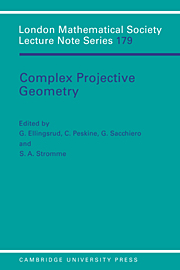Book contents
- Frontmatter
- Contents
- INTRODUCTION
- PROJECTIVE VARIETIES
- VECTOR BUNDLES AND SPECIAL PROJECTIVE EMBEDDINGS
- LIST OF PARTICIPANTS
- Speciality one rational surfaces in P4
- Bounding sections of bundles on curves
- The smooth surfaces of degree 9 in P4
- Compactifying the space of elliptic quartic curves
- Threefolds of degree 11 in P5
- Complete extensions and their map to moduli space
- On the Betti numbers of the moduli space of stable bundles of rank two on a curve
- Gaussian maps for certain families of canonical curves
- Geometry of the Horrocks bundle on P3
- Stability and restrictions of Picard bundles, with an application to the normal bundles of elliptic curves
- Sections planes et majoration du genre des courbes gauches
- A tribute to Corrado Segre
- Un aperçu des travaux mathématiques de G.H. Halphen (1844–1889)
- The source double-point cycle of a finite map of codimension one
- Fibré déterminant et courbes de saut sur les surfaces algébriques
- Courbes minimales dans les classes de biliaison
- Fano 3-folds
- Polarized K3 surfaces of genus 18 and 20
- Protective compactifications of complex afflne varieties
- On generalized Laudal's lemma
- Sur la stabilité des sous-variétés lagrangiennes des variétés symplectiques holomorphes
- Introduction to Gaussian maps on an algebraic curve
- Some examples of obstructed curves in P3
Polarized K3 surfaces of genus 18 and 20
Published online by Cambridge University Press: 06 July 2010
- Frontmatter
- Contents
- INTRODUCTION
- PROJECTIVE VARIETIES
- VECTOR BUNDLES AND SPECIAL PROJECTIVE EMBEDDINGS
- LIST OF PARTICIPANTS
- Speciality one rational surfaces in P4
- Bounding sections of bundles on curves
- The smooth surfaces of degree 9 in P4
- Compactifying the space of elliptic quartic curves
- Threefolds of degree 11 in P5
- Complete extensions and their map to moduli space
- On the Betti numbers of the moduli space of stable bundles of rank two on a curve
- Gaussian maps for certain families of canonical curves
- Geometry of the Horrocks bundle on P3
- Stability and restrictions of Picard bundles, with an application to the normal bundles of elliptic curves
- Sections planes et majoration du genre des courbes gauches
- A tribute to Corrado Segre
- Un aperçu des travaux mathématiques de G.H. Halphen (1844–1889)
- The source double-point cycle of a finite map of codimension one
- Fibré déterminant et courbes de saut sur les surfaces algébriques
- Courbes minimales dans les classes de biliaison
- Fano 3-folds
- Polarized K3 surfaces of genus 18 and 20
- Protective compactifications of complex afflne varieties
- On generalized Laudal's lemma
- Sur la stabilité des sous-variétés lagrangiennes des variétés symplectiques holomorphes
- Introduction to Gaussian maps on an algebraic curve
- Some examples of obstructed curves in P3
Summary
A surface, i.e., 2-dimensional compact complex manifold, S is of type K3 if its canonical line bundle Os(Ks) is trivial and if. An ample line bundle L on a K3 surface S is a polarization of genus g if its self intersection number (L2) is equal to 2g - 2, and called primitive if implies k = ±1. The moduli space Fg of primitively polarized K3 surfaces (S, L) of genus g is a quasi-projective variety of dimension 19 for every g ≥ 2 ([15]). In [12], we have studied the generic primitively polarized K3 surfaces (S, L) of genus 6 ≤ g ≤ 10. In each case, the K3 surface S is a complete intersection of divisors in a homogeneous space X and the polarization L is the restriction of the ample generator of the Picard group Pic X ≃ Z of X.
In this article, we shall study the generic (polarized) K3 surfaces (S, L) of genus 18 and 20. (Polarization of genus 18 and 20 are always primitive.) The K3 surface S has a canonical embedding into a homogeneous space X such that L is the restriction of the ample generator of Pic X ≃ Z. S is not a complete intersection of divisors any more but a complete intersection in X with respect to a homogeneous vector bundle V (Definition 1.1): S is the zero locus of a global section s of V. Moreover, the global section s is uniquely determined by the isomorphism class of (S, L) up to the automorphisms of the pair (X, V). As a corollary, we obtain a description of birational types of F18 and F20 as orbit spaces (Theorem 0.3 and Corollary 5.10).
- Type
- Chapter
- Information
- Complex Projective GeometrySelected Papers, pp. 264 - 276Publisher: Cambridge University PressPrint publication year: 1992
- 33
- Cited by

